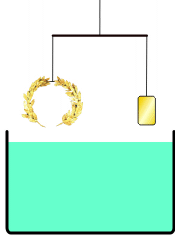Archimedes' principle facts for kids
Archimedes' principle is a famous science rule named after a brilliant Greek scientist named Archimedes. He discovered it while taking a bath! This principle helps us understand why things float or sink. It connects something called 'buoyancy' to 'displacement'.
Contents
What is Archimedes' Principle?
Archimedes' principle explains that when an object is placed in a fluid, the fluid pushes up on it. This upward push is called buoyancy. A fluid can be a liquid, like water, or a gas, like air.
The principle says that the upward push (buoyancy) on an object is exactly equal to the weight of the fluid that the object pushes out of the way. This "pushed out" fluid is called the displaced fluid.
- If an object floats, it means the upward push from the fluid is strong enough to hold it up. The weight of the fluid it displaces is equal to the object's own weight.
- If an object sinks, it means the upward push is not strong enough. The object displaces a volume of fluid equal to its own volume.
In short: Buoyancy equals the weight of the fluid pushed aside.
Archimedes and the Golden Crown
Archimedes used his principle to solve a big problem for the King of Syracuse. The King had given a goldsmith some pure gold to make a new crown. But the King suspected the goldsmith had cheated him by mixing cheaper metals with the gold. He asked Archimedes to find out without damaging the crown.
Archimedes realized he could use his principle to figure out if the crown was pure gold. He knew that pure gold has a specific density. Density tells us how much "stuff" is packed into a certain space. If the crown was mixed with other metals, its density would be different from pure gold.
Here's the idea:
- First, you need to know the density of pure gold.
- Then, you find the density of the crown.
- You can find the crown's density by weighing it in the air and then weighing it while it's fully underwater. When an object is underwater, it feels lighter because of the upward push (buoyancy). The difference in weight helps you figure out its density.
- If the crown's density matches pure gold, it's real! If it's different, the goldsmith cheated.
This is why Archimedes famously shouted "Eureka!" (meaning "I have found it!") when he made this discovery.
Another Way to Check the Crown
We don't know for sure if Archimedes used exactly the method described above. Another way he might have done it is by using a balance scale.
- He could have placed the crown on one side of the scale.
- On the other side, he would place a piece of pure gold that weighed exactly the same as the crown in the air.
- Then, he would lower both sides of the scale into a large container of water.
- If the crown was not pure gold, it would be less dense than gold. This means it would take up more space (have a larger volume) for the same weight.
- Because it takes up more space, it would displace more water. More displaced water means a greater upward push (more buoyancy).
- So, if the crown was fake, it would feel lighter in the water than the pure gold. The scale would tip, with the crown side going up and the pure gold side going down. This would show the King that the crown was not pure!
Images for kids
See also
 In Spanish: Principio de Arquímedes para niños
In Spanish: Principio de Arquímedes para niños





